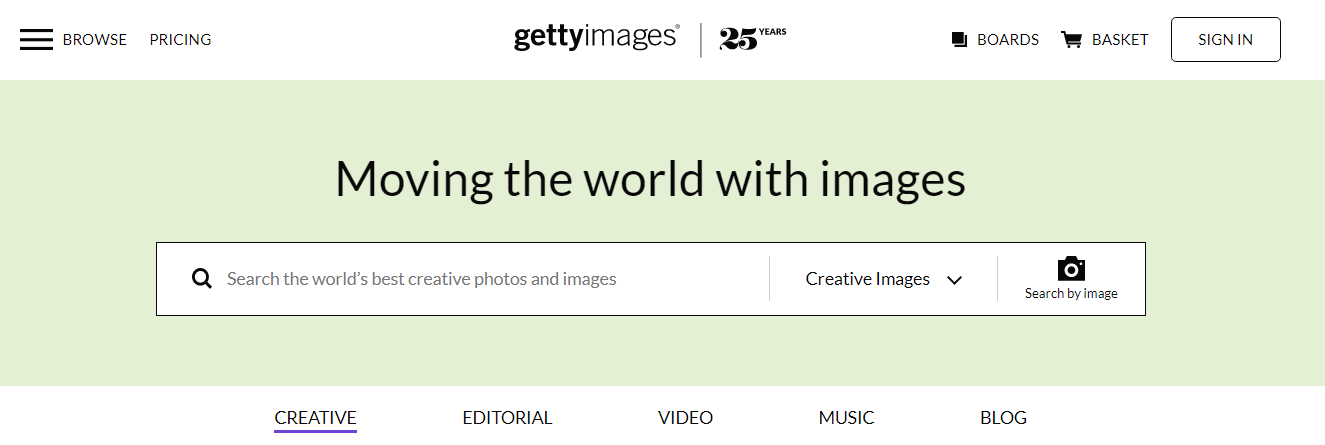Are you a photographer looking to turn your passion into profit? Selling your photos on Getty Images is a fantastic way to reach a global audience. With millions of users searching for high-quality imagery, this platform can be your gateway to earning money from your photography. However, understanding how to effectively manage your portfolio is crucial. Let’s explore how you can get started and make the most of your offerings on Getty Images!
Understanding the Getty Images Platform

Getty Images is one of the largest and most reputable stock photography platforms in the world. It's a place where photographers can showcase their work, and businesses or individuals can purchase high-quality images for various projects. Here’s a breakdown of fundamental aspects of the platform that every seller should know:
- What is Getty Images?
Getty Images is a stock photo agency that provides an extensive library of images, videos, and music. It caters to a diverse clientele, including advertisers, media companies, and creative professionals seeking compelling visuals for their projects. - Your Role as a Contributor
As a contributor, you have the opportunity to upload your photographs and earn royalties each time someone downloads your image. It’s an excellent way to monetize your craft while enhancing your visibility as a photographer. - Portfolio Management
Effective portfolio management is key to success on Getty Images. Regularly updating your portfolio with fresh, relevant content helps you stay competitive. Focus on specific themes or niches you excel in—be it landscapes, portraits, or lifestyle shots. This helps you establish a brand identity. - Keywords and Metadata
Properly tagging your images with relevant keywords and metadata is crucial for discoverability. Think about what potential buyers might search for and include those terms. The better your metadata, the higher your chances of getting your images noticed. - Analytics and Feedback
Getty Images provides contributors with analytics tools to track performance. Pay attention to which images resonate with buyers and which don’t. Use this data to refine your portfolio and adjust your strategy for future uploads.
In addition to navigating these aspects, familiarize yourself with the types of licenses Getty offers (like editorial vs. commercial use) and keep an eye on the latest trends in photography. Staying informed can give you an edge over other contributors.
In conclusion, understanding the Getty Images platform is the first step to selling your photos successfully. With the right approach and attention to detail, you can effectively showcase your work and tap into a lucrative market. Dive in, experiment, and don’t hesitate to share your unique perspective through your photography!
Also Read This: How Getty Images Sets the Price for Images
3. Building a High-Quality Photo Portfolio

Creating a stunning photo portfolio is essential if you want to sell your photos on Getty Images. This is your opportunity to showcase your best work and make a lasting impression on potential buyers. So, how do you build a high-quality portfolio that stands out? Here are some tips to help you get started:
- Curate Your Best Work: Start by selecting your absolute best images. Quality over quantity is crucial here. Aim for around 20-30 of your strongest pieces that represent your style and expertise.
- Diversity is Key: While you want to play to your strengths, make sure your portfolio includes a range of subjects, styles, and techniques. This diversity can attract a wider audience and increase your selling potential.
- Pay Attention to Cohesion: Although diversity is important, there should still be a cohesive theme or style throughout your portfolio. This could be a specific color palette, mood, or subject matter that reflects your unique vision.
- Optimize for Different Formats: Consider the different ways buyers might use your photos (online, print, etc.). Include images that can suit various formats and contexts, so your work is appealing across the board.
- Showcase Technical Skills: Highlight your technical abilities, whether it's perfect lighting, composition, or post-processing techniques. Every detail matters, and your portfolio should reflect that you understand how to craft compelling images.
- Keep It Updated: As you grow and improve your skills, don’t forget to update your portfolio regularly. Remove older, less compelling work, and replace it with your latest and greatest shots.
Once you've curated your selection, consider how to present it visually. A clean, professional layout can make a huge difference in how your photos are perceived. Whether you’re showcasing your work through a personal website or using Getty’s platform, ensure your images are presented with high resolution and without distractions from other elements.
Also Read This: How to Get Photos from Getty Images Without Watermarks for Personal Use
4. Essential Tips for Managing Your Portfolio Effectively
Now that you've put together a high-quality portfolio, managing it effectively is crucial to your success on Getty Images. Here are some essential tips to help you stay organized and maintain your portfolio's appeal:
- Use Metadata Wisely: When uploading your photos, use tags, keywords, and descriptions to enhance discoverability. Think about what potential buyers might search for and include those terms. This can significantly increase the chances of your images being found.
- Monitor Trends: The photography market is always evolving. Keep an eye on current trends, seasonal demands, and buyer preferences. Staying informed can help you tailor your portfolio to meet market needs effectively.
- Engage with Feedback: Pay attention to which images get the most views and downloads. Feedback from users can provide insights into what works and what doesn’t. Be open to making changes based on this data.
- Track Your Sales Performance: Regularly review your sales analytics to understand which types of images sell best. This information can inform your future shoots and help you build a more targeted portfolio.
- Network and Collaborate: Connecting with other photographers, industry professionals, and potential buyers can open doors for new opportunities. Collaboration can also enhance your portfolio through diverse projects and shared creativity.
- Stay Organized: Keep your original files organized, and ensure that everything is backed up. Use a consistent naming and filing system, so you can easily access your work when you need to make updates or provide additional content.
Effective portfolio management is an ongoing process. By regularly refining and optimizing your collection, you not only increase your chances of making sales on Getty Images but also grow as a photographer. Keep experimenting, learning, and adapting, and you’ll find success in your photographic endeavors!
Also Read This: How to Handle a Getty Images Letter: What You Should Know
5. Optimizing Your Photos for Search and Sales
When it comes to selling your photos on Getty Images, simply uploading your images isn’t enough. You need to optimize them so that potential buyers can find them easily. Here are some tips on how to do just that:
- Use Relevant Keywords: Keywords are essential for searchability. Think about what a buyer might type into the search bar when looking for images. Use specific, descriptive keywords that reflect the subject, mood, and style of your photos. For example, instead of just “sunset,” try “vibrant sunset over a calm lake.”
- Write Engaging Descriptions: A good photo description can make a significant difference. Explain the context, setting, and any story behind the image to give it depth. Remember, this is your chance to sell your photo, so be descriptive but concise.
- Tag Effectively: Along with keywords, utilize tags wisely. This extra layer of categorization can help buyers find your photos in more specific searches. Use both broad terms and niche tags.
- Choose the Right Categories: When you submit photos, make sure to place them in the most appropriate categories. This makes it easier for buyers looking for specific types of images to discover your work.
- Leverage Image Quality: High-quality images not only attract buyers but also tend to rank better in searches. Ensure your photos are sharp, well-composed, and free from distractions. Consider post-editing to enhance brightness, contrast, and sharpness.
Lastly, remember that visual storytelling matters. An image that evokes emotion or tells a story can increase its appeal. So, when optimizing, think about how your photo can resonate with the audience. Combining technical quality with a compelling narrative will significantly boost your chances of making sales on Getty Images.
Also Read This: How to Become a Model for Adobe Stock Images
6. Pricing Your Photos on Getty Images
One of the most critical aspects of selling your photos on Getty Images is understanding how to price them effectively. Striking the right balance between value and temptation can be tricky, but these tips can help:
Understand Market Rates: Research is your best friend. Take a look at similar photos in your niche on Getty Images to get a sense of trend pricing. Consider factors like image quality, composition, and subject matter. A groundbreaking nature shot might fetch more than a standard corporate image.
Consider Licensing Types: Getty Images offers different licensing options—royalty-free (RF) and rights-managed (RM). Generally, RM images can be priced higher due to their exclusivity and licensing restrictions. Understanding these can help you implement appropriate pricing strategies.
Set Competitive Prices: Don’t undervalue your work, but also avoid overpricing. Find a sweet spot where your images are enticing yet profitable. Consider starting with an introductory price for your first uploads to attract buyers and gradually adjust as your portfolio grows.
| Image Type | Suggested Price Range |
|---|---|
| Royalty-Free Stock Image (Standard) | $25 - $150 |
| Royalty-Free Stock Image (Enhanced) | $150 - $500 |
| Rights-Managed Stock Image | $300 - $2,500+ |
Consider Audience Demand: Pay attention to trends and seasonal demand—if certain types of images are in higher demand (think holiday themes or summer activities), adjust your pricing accordingly. Being flexible and responsive can dramatically improve your sales.
Finally, don’t forget to review your pricing strategy regularly. The market changes, and so do buyer preferences. Regularly assessing your prices and adjusting them based on your growing experience can keep you competitive and thriving in the stock photography world.
Also Read This: Alamy vs Unsplash: Comparing Two Platforms for Free and Premium Stock Images
7. Promoting Your Getty Images Portfolio
So you’ve carefully curated your portfolio on Getty Images, and now it’s time to get those stunning photos in front of as many eyes as possible! Promoting your Getty Images portfolio can be a game changer, boosting not just your visibility but also your sales. Here’s how you can effectively promote your work:
- Utilize Social Media: Platforms like Instagram, Facebook, and Twitter are fantastic for showcasing your photography. Share your portfolio link in your bios, post sneak peeks of new images, and interact with your audience. Use popular hashtags related to photography and specific themes to expand your reach.
- Join Photography Communities: There are numerous online forums and groups dedicated to photography, such as photography-focused Facebook groups or Reddit. Share tips, engage with fellow photographers, and subtly promote your Getty Images portfolio when appropriate.
- Create a Personal Website: Having a personal website that links to your Getty Images portfolio can establish your brand as a photographer. Include a blog where you discuss your work, photography tips, or stories behind your favorite shots, which can drive traffic to your portfolio.
- Email Marketing: If you have a list of contacts – past clients, friends, or other photographers – consider sending a newsletter. Highlight your best images, link to your Getty portfolio, and encourage them to share your work.
- Consider Collaborations: Team up with other photographers or creatives to cross-promote each other's work. Whether it’s through joint projects, Instagram takeovers, or blog features, collaboration can help expose your portfolio to new audiences.
Remember, consistency is key! Regularly promote your portfolio but balance it with genuine interactions. People are more likely to engage with and follow you if they feel a connection before your sales pitch.
Also Read This: iStock vs Shutterstock Comparing Features Quality and Pricing
8. Monitoring Your Sales and Adjusting Your Strategy
Once your portfolio is live and you’ve started promoting it, the next step is to keep an eye on how well your images are performing. Understanding your sales data is essential for adapting your strategies and maximizing your profits on Getty Images. Here are some tips for effective monitoring:
- Track Your Sales Data: Getty Images provides access to sales reports that can help you determine which images are performing well. Focus on metrics such as downloads, earnings, and trends. This data will inform you about what your audience loves and what themes or styles resonate the most.
- Analyze Customer Feedback: If you receive feedback or inquiries about certain images, take note! This can provide valuable insights into market needs and preferences. Adjust your portfolio to cater more to those trends.
- Experiment with Pricing: Test different pricing models for your images. You might find that adjusting the price can lead to increased sales. Monitor the results of these changes closely to see what resonates.
- Refresh Your Portfolio: Regularly updating your portfolio with fresh content can keep it relevant. Make sure to replace underperforming images with new ones that you think will attract interest. This will help maintain a dynamic and exciting collection.
- Stay Educated: Keep an eye on industry trends and evolving buyer preferences. Follow photography and stock image blogs, attend webinars, or participate in workshops. Continuous education can inspire new strategies and approaches that resonate with your audience.
Remember, it’s perfectly fine to adjust your strategy as you go. The key to success in the competitive world of stock photography is flexibility and responsiveness to data!
Conclusion and Next Steps for Aspiring Photographers
In summary, selling your photos on Getty Images can be a rewarding venture if approached strategically. *Effective portfolio management is crucial for standing out in a competitive market. Here are some key takeaways and actionable steps to propel your photography career:
- Curate Your Portfolio: Regularly update your portfolio by selecting your best work that aligns with current trends.
- Understand Market Demands: Research popular themes and subjects on Getty Images to stay ahead of the curve.
- Optimize Metadata: Use descriptive keywords and tags for your photos to enhance discoverability.
- Engage with the Community: Network with other photographers and buyers on social platforms and forums.
- Set Realistic Goals: Define specific targets for the number of uploads and sales you aim to achieve each month.
By implementing these strategies, you can significantly increase your chances of success on Getty Images. Remember*, it's essential to be patient and persistent as you build your reputation and portfolio.
As you embark on this exciting journey, take the time to continuously educate yourself, seek feedback, and refine your skills. Embrace both the challenges and successes that come your way, and you'll find yourself progressing as a photographer and a seller.
 admin
admin








